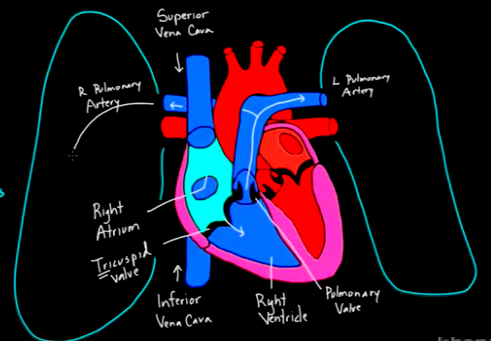And so, if this is my lung, on this side, this is my left lung.
假設這是左肺
And this is my right lung, on this side.
這是右肺
Then these vessels--
那么這些血管-
and I'll let you try to guess what they would be called--these vessels.
大家可以猜一下這些血管叫什么,看這些血管
This would be my--
大家看
I want to make sure I get my right and left straight.
我要標清楚左右
This is my left pulmonary artery.
這是左肺動脈
And I hesitated there just to make sure you got that
我空一下,是為了讓大家想到
because it's taking blood away from the heart.
這是離開心臟的血液

And this is my right pulmonary artery.
這是右肺動脈
So this is my right and left pulmonary artery.
這分別是右肺動脈和左肺動脈
And so blood goes, now, into my lungs.
現在血液進入肺部
These are the lungs that are kind of nestled into my thorax, where my heart is sitting.
肺和心臟都在胸腔中
It goes into my lungs. And remember, this blood is blue.
血液進入肺中-注意,血液用藍色標
Why is it blue?
為什么用藍色呢?
Well, it's blue because it doesn't have very much oxygen.
藍色表示含氧量低
And so one thing that I need to pick up is oxygen.
那么在肺中,要補充的首先是氧氣
And so that's one thing that the lungs are going to help me pick up.
這是肺要完成的工作之一
And I'm going to write O2 for oxygen. And it's also blue.
氧氣用O2表示,藍色標注的血管
And that reminds us that it's full of carbon dioxide.
還告訴我們,血液中二氧化碳含量高
It's full of waste because it's coming from the body.
積累了身體各處產生的廢物
And the body's made a lot of carbon dioxide that it's trying to get rid of.
身體產生了很多二氧化碳,這時要排掉這些廢物
So in the lungs, you get rid of your carbon dioxide and you pick up oxygen.
在肺里,排出二氧化碳,吸收氧氣
So that's why I switch, at this point,from a blue-colored vessel to a red-colored vessel.
大家看,這里血管從藍色變成了紅色
So now blood comes back in this way and this way and dumps into this chamber.
血液從這里回去進入這個房室
So what is that?
它叫什么呢?
This is our left atrium.
這是左心房
So just like our right atrium, we have one on the left.
跟右心房對應,左邊是左心房
And it goes down into--and you can probably guess what this one is called--
然后血液流入--大家應該能想到這個叫什么
it's our left ventricle.
這是左心室











